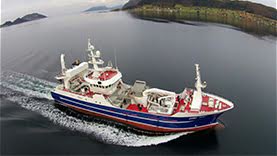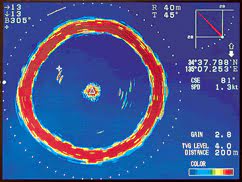Mullglen instala conversores de medios de Perle para eliminar las interferencias electromagnéticas (EMI) de la transmisión de datos realizada por el sónar
Tras cinco años de transmisión de datos poco fiable en barcos de arrastre, el problema llega a su fin con la instalación de una red de fibra para la transmisión de los datos del sónar detector de pesca.
Las embarcaciones pesqueras modernas están totalmente equipadas con electrónica naval, dentro de la que se incluyen sistemas de radar, detectores de pesca e instrumentos de navegación para localizar grandes bancos de peces. Una pieza clave del equipo es el sónar detector de pesca, que permite encontrar objetos sumergidos mediante ondas sonoras. El sónar transmite ondas ultrasónicas por el agua y recibe el eco que devuelven al rebotar en el lecho marino. Para localizar los bancos de peces, el sónar muestra una imagen parecida a la de un radar de la masa de agua que rodea a la embarcación. Furuno, un fabricante japonés, vende estos dispositivos por un precio superior a 250 000 £ a barcos de arrastre de todo el mundo que dependen de ellos para localizar las zonas de pesca.
Ronan Murrin, ingeniero naval de Mullglen Limited, trabaja a bordo del barco de arrastre Pacelli, con sede en Irlanda.

La antena del sónar se encuentra en la parte delantera del barco sumergida en el agua y envía un pulso que es recogido de nuevo por el transductor. Los datos se envían a través de un cable de par blindado cat7 de 64 m de longitud al puente, donde un ordenador los recibe para que el patrón y el capitán puedan visualizarlos. El patrón y el capitán interpretan los datos para poder tomar decisiones fundamentales para la navegación
.
Pocos días después de que se instalara un nuevo sónar detector de pesca en el Pacelli, el patrón, que cuenta con más de 40 años de experiencia, se dio cuenta de que no estaba funcionando correctamente.
Murrin comenta que el patrón conoce estas aguas. Sabe dónde están las rocas ahí abajo y se dio cuenta de que el sónar no las estaba registrando. Estaba claro que el sónar era poco fiable y que ya no podríamos volver a confiar en él
Furuno invirtió mucho tiempo y recursos en intentar encontrar una solución a estas cuestiones de fiabilidad. Se sustituyeron tanto el transductor como la unidad del procesador. Se actualizó el cableado del barco de cat5 a cat7. Asimismo, un ingeniero japonés pasó cuatro semanas en el barco, aunque todo fue en vano.

Tras cinco años de idas y venidas, Mullglen aún no había sido capaz de dar con una solución. Con su dilatada experiencia como electricista e ingeniero, Murrin dio un paso atrás.
Explica que: Al principio decidí instalar un sistema de alimentación ininterrumpida (UPS, por su sigla en inglés) que proporcionaría al equipo del sónar una potencia de 240 V en todo momento. Debido a todos los generadores, los motores y al equipo de refrigeración que había a bordo, las subidas de tensión y los apagones eran algo común. Entonces recordé un curso que había hecho anteriormente sobre fibra óptica. Investigué sobre el tema y me puse en contacto con un ingeniero de Perle. La cuestión de la fiabilidad de la red de fibra óptica, así como el hecho de que la fibra no se ve afectada por las interferencias eléctricas, cobraron de repente todo su sentido. El ingeniero de Perle me explicó cómo los diferentes tipos de datos se podían transmitir utilizando conversores de medios, así que desde ese momento estuve seguro al 99 % de que esa era la solución que estábamos buscando
Murrin instaló un par de conversores de medios de Ethernet rápidos a bordo del Pacelli. El primero estaba conectado al transductor del sónar en la parte delantera del barco. Los datos se transmitirían a través de la fibra hasta el otro conversor de medios conectado a la pantalla del ordenador del puente.

Murrin describe el resultado: Al desplazarnos a los caladeros, solíamos dejar el sónar apagado, ya que solo podía estar operativo un par de horas para que los datos no se volvieran confusos. Al instalar la fibra, podíamos encenderlo incluso cuando aún estábamos en el puerto. El patrón conoce el lecho marino como la palma de su mano. Quiso comparar los datos obtenidos con el sónar con lo que él ya sabía. Funcionó perfectamente durante dos horas, por lo que decidió apagarlo hasta que llegamos al caladero. Entonces lo encendió y así permaneció de forma ininterrumpida durante cuatro días. Y funcionó perfectamente
Las EMI se producen en los cables coaxiales, incluso en los blindados. Las rutas que el cableado puede tomar en un barco son muy limitadas y a menudo varios cables están colocados muy cerca entre sí. Esto aumenta las probabilidades de que se produzca una EMI. Las EMI no afectan a la fibra óptica, ya que las señales se transmiten en forma de luz y no de corriente. La señal se puede transmitir en lugares donde normalmente las EMI bloquearían la transmisión.
Ronan comenta lo siguiente a modo de conclusión: El fabricante del sónar invirtió mucho tiempo y recursos intentando enmendar el problema. Al final, solucionamos el problema dedicando muy poco dinero y esfuerzo gracias a los dos conversores de medios de Perle
La empresa Mullglen Limited es una flota pesquera irlandesa que se constituyó en 1992.